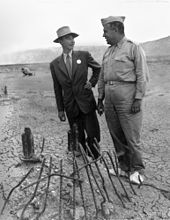The Manhattan Project
Leslie Groves and J. Robert Oppenheimer 1942-1946
General Leslie Groves (1896-1970) had a strong track record in managing major projects, including among others the construction of the Pentagon (1941-1943). The Manhattan Project was under enormous time pressure, partly because intelligence suggested that Nazi Germany was further ahead with nuclear weapons research than was actually the case. Groves chose to de-emphasise the kind of prototyping that was common in military projects of the day in order to save time. In a move that foreshadowed Agile development practices, he was also willing to move forwards with only partially completed plans, using an energetic work ethos, determination, disciplined modularisation and careful recruitment to compensate.
In the same spirit, Groves consulted extensively with domain experts before choosing courses of action. The final decisions were, however, taken by himself, and he proved to have a talent for selecting expedient courses of action, and, perhaps more importantly given the time constraints, rejecting the inefficient early in the process. He was also very disciplined with respect to security, and part of this overall management strategy was that domain experts "stick to their knitting", i.e. each of the many different functions of the project was highly self-contained and had limited knowledge about what the other functions were doing.

In 1942 Groves appointed J.Robert Oppenheimer (1904-1967) to head the project's secret weapons laboratory. Oppenheimer's appointment was controversial, in part because he did not have a strong management track record, but he did have formidable interpersonal skills. Oppenheimer also shared Grove's practice of creating environments and situations that allowed people to remain focused on their tasks without outside interference or disturbance. Through insisting on Oppenheimer's appointment in the face of significant opposition, Groves ultimately demonstrated that organisational techniques alone are not the only key to the delivery of major/difficult projects.
DuPont, one of the major contractors on the project, developed a set of management practices between 1940 and 1943 that contributed significantly to the development of the Critical Path Method (see below).
